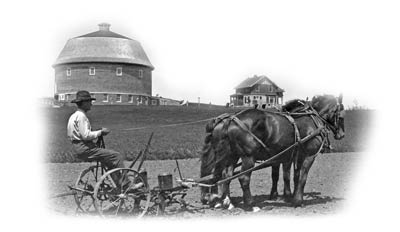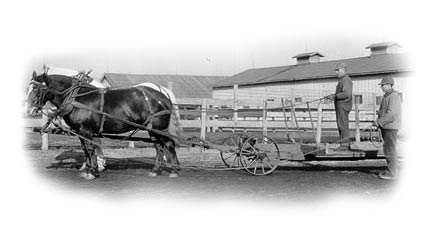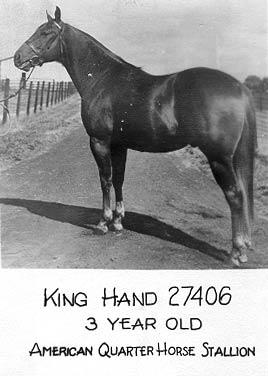
Round Barns at the University of Illinois 1904
In 1897, soon after Davenport had been appointed dean of the College of Agriculture, he began a breeding program for Morgan horses. One of the first Animal Husbandry divisions to be established under Herbert Mumford was the Horse Division in 1903. This situation was apparently unusual, as Dean Davenport stated in a Daily Illini article that “This is also the only University in the world that employs a horse expert…Strangely, the horse is given but very little attention at other institutions. The University horses are purebred Morgans and several of them are kept at the barns on the south farm [south campus]”.
The wooden Mare Barn was built in 1911. The breeding of draft horses was the main interest of the division, with an emphasis on Percherons . Included in the University herd were 29 purebred Percherons, including five mares imported from France, five American-bred mares, ten two-year-old fillies, seven colts, and two imported stallions. Care was taken to choose animals of both good breeding stock and good show records. The division also had nine registered, five-gaited, Saddlebred light horse mares and four Hackney ponies. For farm work there were ten to fifteen geldings and mules.

Draft Horses Working
The Animal Husbandry Department was using purebred draft horses, Percherons, for their farm work. A herd was developed in the early 1920s that included stallions, brood mares, and young stock. In 1923, J.L. Edmonds traveled to France to purchase a Percheron stallion to improve the draft horse breeding program. Named “Urometre,” the imported stallion headed a program of about forty Percheron horses and was a very successful breeder of prize-winning foals. A new horse barn (“Tile” Barn) was built in 1924 by King & Petry Company for $29,655 from designs of University Architect, James White. This barn was a tie-stall barn that housed the Percherons. A second French Percheron stallion was purchased in 1928.
Apparently, the University of Illinois was one of the last large farm operations to switch to tractors, continuing to use draft horses for farm work into the early 1950s. The last working purebred Percheron working draft team, Illini Jolly and Illini Nettie , were sold at auction in October, 1953; however, a lighter team was kept for minor chore work at the beef barns. After World War II, the University proposed starting a program for the breeding, feeding, and care of light horses. The Quarter Horse herd was established in 1948 with seven mares and two stallions. Eventually, only mares and sires from the King Ranch (Texas) were used in the program.
In an economy move, the horse program was transferred to the University’s Dixon Springs Experiment Station in 1960. Two years later (1962), the entire herd was sold at auction and the horse program was disbanded. This action was taken due to rising operational costs and a need by the College of Agriculture to concentrate its efforts on livestock of more economic importance to Illinois agriculture. In addition, the University’s herd was too small for teaching or research purposes. Following the sale, the South Farm horse facilities were either vacant, used by other divisions for storage, or by other University departments. Beef cattle were housed in the Mare Barn and the Tile Barn’s west wing was remodeled in 1961-1963 with a K-40 radioactive counter installed; the kinesiology program of the School of Arts and Sciences used the area extensively at least through the 1980s.

King Hand – 1952
Popular demand in the early 1970s brought back the horse program. Increasing enrollment in the single equine course and increased interest in the livestock judging team for a horse component, led to repeated requests for horses to return to the South Farm. Gradually the program was expanded and numerous light horses were donated to the University in the 1970s. Most of these were Quarter Horses of Skipper W breeding.
The first Standardbred stallion to serve significant books of mares arrived at the farm for the 1993 breeding season. The arrival of Napatross , 1986, P, 3, 1:54.2M ($211,826) (Niatross – Napa Valley – Most Happly Fella), marked the beginning of a concerted effort by the University Horse farm to breed high quality Standardbreds. Napatross stood at the University horse farm through the 1999 breeding season. During that time he produced two of his best offspring FlyHy Illini (1994), p, 7, 1:52.4M, ($169,572) out of a University owned mare FlyHy Henka , and The Joking Man (1997), p, 6, 1:52.0M, ($332,877).
In the mid-nineteen-nineties the breeding facility was modernized with a new facility designed and installed in the rear of the Tile Barn. This installation has a modern laboratory, stallion collection area, and four mare examination areas. The new facility allowed for breeding short courses as well as providing better research and educational programs.
Carl Becker, University of Illinois alumnus and owner of Fair Meadow Farm in Altamont, Illinois significantly transformed the teaching and research opportunities as well as the financial well-being of the University horse farm. Through long-term lease agreements, the UI horse farm committed to stand Mr. Becker’s stallions for public breeding. Animal Sciences and Veterinary students at UI have been given an unprecedented opportunity to learn first hand about the workings of a successful commercial horse breeding operation, through working with Mr. Becker’s outstanding breeding stock which has included the stallions Armbro Mackintosh, Park Place, Kingston, Cheyenne Spur, Rosemont Principal, Western Hero, Soutwind Breeze and Duneside Perch.
The Standardbred breeding program for the University horse farm received a major boost in 1998 with the arrival of Armbro Mackintosh, 1991, p, 3, 1:51.1 ($471,628) (Jate Lobell – Apple Country – Strike Out) . Mack had already produced Woodsie and Buster (P, 3 1:52.1M, $479,919) who was racing in New Jersey and having a phenomenal year as a three year old in 1998. In 1999, Mack was named the Illinois Pacing Stallion of the Year. Mack proved to be a great asset for the horse farm as was a consistent producer of fast racehorses, especially his daughters. Mack’s top racing mare Free, p, 4,1:49.2 ($531,259) was the co-fastest race-timed mare in history when she dropped a heartbreaking photo finish to great World Champion mare My Little Dragon p, 4, 1:48.1 (2,059,986) in that mare’s world record mile. This top stallion was humanely euthanized during the summer of 2008 at 17 years of age due to complications from a longstanding case of chronic founder dating from his 3 Year Old racing season.
Another pacing stallion standing at the horse farm from 2001-2003 was Kingston, 1985, P, 3, 1:52.2M ($154,434) (Big Towner – Florita Lobell – Albatross). This journeyman stallion was a fast, tough, and gutsy racehorse that sired the same sort of offspring like Kgbrina Willowbee P, 6, 1:53 ($267,200), Luckystar Willowbee P, 9, 1:53.2 ($229,930), Black Tie Bobby P, 4, 1:52.4 ($221,536) and King’s Narcissus P, 3, 1:52.3 ($207,090).
The UI Horse Farm has stood a few trotting stallions as well. From 2000 until his death in 2002, the horse farm stood a trotter named Cheyenne Spur, 3, 1:56.2F ($353,265) ( Super Bowl – Memory Hanover – Speedster ). After his death, he was replaced by Rosemont Principal, 1997, 2, 1:58.2F ($94,900) (Donerail – Keystone Paulina – Super Bowl). Rosemont Principal was a fast stakes winning colt by Donerail, and he sired a few good sub 2-minute trotters, but did not prove to be commercially successful in Illinois.
In 2003, Park Place, 1994, P, 3, 1:51.0M ($765,552) (Artsplace – Deneen’s Delight – Most Happy Fella) was purchased by Carl Becker and Peter Spaeth and stood at the horse farm for the first time in 2003 after servicing small books of mares in Ohio and Northwestern Illinois. During his racing career, Park Place established himself as one of the fastest pacers in history, being timed in 24.2 seconds for a quarter mile and 1:48.4 for a mile. The University horse farm produced numerous winners by Park Place, who proved to be an outstanding success at stud. The top Park Place foal raised at UI was the 2007 Illinois Season’s Champion, Little Pedro p, 2, 1:50.4 ($92,544) and Park Place’s best race horse ever was the great Ohio-bred, Buckeye One p, 5, 1:48.1S ($915,530). Park Place died prematurely after colicking in the spring of 2008.
Beginning with the 2007 breeding season, the UI Horse Farm acquired the services of the pacing stallion Western Hero p, 2, 1:53.2; 5, 1:51.3 ($182.309). Western Hero is a full brother to the outstanding Pennsylvania sire Western Ideal p, 5, 1:48 ($1,455,422) who has become a famous sire of sires, as his sons Rocknroll Hanover and American Ideal have proved to be sensational stallions. Western Hero was a successful sire in Maryland and Indiana before coming to Illinois and has himself sired 24 winners of over $100,000 from limited opportunity.
The UI Horse Farm added the young trotting stallion Southwind Breeze T, 2, Q, 1:57.4F in the spring of 2008. Southwind Breeze is by Conway Hall, out of the fast Valley Victory daughter Believe In Victory T, 3, 1:56. Southwind Breeze proved to be a very consistent sire of quality trotters, but encountered fertility problems later in his career and moved to new quarters in 2017. While at the UI, though, he produced outstanding trotters like BIG BILL BREEZE T 8, 1:53.4 F ($391,637), LITTLE MS CHRISSY T 4, 1:53.4 M ($262,526), BAILEY’S WISH T 3, 1:55.0 M ($223,035) and DIVINATION T 5, 1:54.4 F ($194,591)
In 2009, the blazing fast young pacer, Duneside Perch p, 2, 1:50.2 was added to the UI Horse Farm’s stallion roster. As a racehorse, Duneside Perch won the 2 YO $175,000 NJSS Finals win in an awe-inspiring stakes-record 1:50.2 at The Meadowlands. Duneside Perch was timed during each of his first three 2 YO starts faster than any 2 YO had ever gone at comparable times of the year. Many knowledgeable horsemen believe that he had the most precocious early speed of any Standardbred to ever step on the race track. Duneside Perch is the fastest two year old to ever enter the stud in Illinois! Duneside Perch is from a notable maternal family that includes top horses like Bunny Lake p, 6, 1:49 ($2,843,476), Speed Again p, 4, 1:48.1S ($686,834), Art Professor p, 4, 1:47.4S ($578,870) and Powerful Mist p, 4, 1:50F ($618,631). Standout stakes-winners from the first 2 crops of Duneside Perch include Unlocked p 2, 1:53.2 ($113,672), Silver Devil p 3, 1:52.0 ($104,554) and Special Rose p 2, 1:54 ($103,578).
From 2011 – 2012, the fast and royally-bred trotter Yankee Valor T, 4, Q 1:54.1 ($110,731) joined the UI stallion ranks. Yankee Valor initially stood stud in Indiana, and sired several good Indiana-bred race horses including Serene’s Yankee Boy T 3, 1:55.2 S ($83,862), Flower Girl Charis T 3, 1:58.0 ($51,750) and Hoosier Paco T 3, 1:58.4 F ($39,379). Yankee Valor was replaced at the UI Horse Farm by the exciting young trotter Cassis in 2013, as below.
During the 2012 breeding season, the UI added another ultra-fast pacing stallion, Sagebrush p, 1:49 ($646,967), who had bred only a small number of mares while serving stud duty at Entropy Farm in Woodstock. IL. Sagebrush proved his worth as a major stallion by siring 26 winners from only 39 foals in his first few small crops. His stakes-winners include Nj’s Big Deal p 4, 1:50.1 ($298,409), Sleazy Does It p 5, 1:51.3 ($262,877), Backstreet Lawyer P, 4, 1:49.3 M ($249,787), Dee Dee Sage p 4, 1:52.0 ($216,599) and 2013 Orange and Blue 2 YO Filly Stake Champion Thesleazyprincess p 2, 1:54.3 ($304,287). Sagebrush has served nearly 350 mares since arriving at the UI Horse Farm.
The year 2013 marked the arrival of one of the finest-bred Standardbred trotting stallion to ever reside in Illinois. Cassis T 3, 1:52.4 ($575,126) won the fastest elimination (1:52.4) of the 2010 Hambletonian over top-notch competition including the great Wishing Stone T, 3, 1:51.2 ($2,233,820) and reeled off 8 wins and 2 second place finishes in his first 10 starts at 3 years of age. For novices to the harness racing world, The Hambletonian is a fabled race of similar stature to the Kentucky Derby for Thoroughbreds. Cassis is by the great Cantab Hall, the 2012 and 2013 Trotting Stallion of the Year and the leading money-winning trotting sire of all-age performers. Cassis’ sire line has been one of the most dominant in the breed for several years when one also considers the short but incredibly productive career of his grandsire Self Possessed. While residing at the UI Horse Farm, Cassis sired standouts such as Anna’s Lucky Star T 4, 1:53.1 M ($429,682), Trotting Grace T 4, 1:54.1 H ($324,341) and Trixie’s Jethro T 6, 1:54.3 H ($288,512).
In 2019, the UI Horse Farm added the fast trotting son of Muscle Hill named New Jersey Viking T, 4, 1:52.4 M ($220,048), and the half-brother to Champion pacer Artspeak, named Fort Knox P, 6, 1:50 F($261,256).
Such outstanding Standardbred stallions require support from outstanding broodmares, so it has been our goal to acquire quality Standardbred broodmares from top families to cross on these stallions and further support their genetically superior sire lines.
In addition to having a thriving Standardbred breeding program, the UI horse farm has been home to research that has contributed to the knowledge base in equine nutrition, physiology, reproduction and parasitology. UI horses were used in the research leading to the approval of the widely used de-worming compound, Interactive, and in the establishment of blood gas testing policies used by racing commissions around the world. Current research is investigating the usefulness of various dietary fats in horse diets, investigating ways to reduce osteochondrosis in growing horses, and determining the effects of various methods of feed processing on digestibility, growth and feed efficiency of growing horses.

